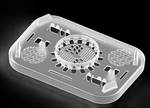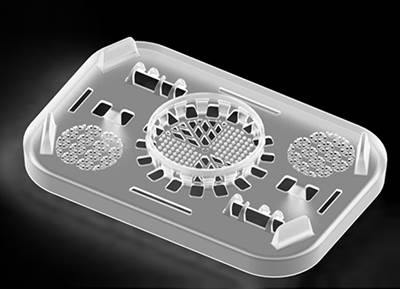Dry-Ice Cleaning Pays Off Big For High-Tech Molder
Mold running time has been increased by 200-500% at Performance Plastics.
Performance Plastics, Cincinnati, is a custom molder specializing in small, complex precision parts in high-performance engineering materials for the medical-device, energy, aerospace/defense, industrial, electronics, and food/ beverage industries (see July ’12 On-Site feature).
“From design through production, we do what others have dreamed of, failed at, or said can’t be done,” says Tom Mendel, president and CEO. “We are defined not by the industry served, but by the materials we run, the sophisticated tooling we use, and the tight tolerances we hold. We are pushing the envelope here—running 150 mph in a 20-mph zone. We do lots of R&D, lots of engineering, and lots of hard stuff.”
The molder has aggressively lowered its per-part cost with a proprietary, high-volume, direct-gating hot-runner process. The molder has run PEEK since it was first introduced in the early 1980s, and is an approved processor of Torlon (Solvay’s polyamide-imide). Performance Plastics also been involved in development work with LCPs, and is one of the few molders able to run FEP fluoropolymer in eight-cavity, high-volume molds with hot runners.
Keeping the mold clean is a must for any processor. But in Performance Plastics’ case there are two challenges. First, its molds are heated to 450 F, with melt temperatures soaring as high as 800 F. This generates gases that, when liquefied, can stick to the mold—like tar, as Mendel puts it.
Second, when the plastic runs from one end of the part and flows to the end of fill, the gas must be vented through a very precise opening in the mold—one that lets the gas out but does not allow the polymer to escape. This vent at the end of fill gets clogged from the buildup of the volatiles that condense when the mold is cooled. If the tool doesn’t vent properly, problems occur: The gas can destroy the mold material and affect part quality
Mold cleaning usually requires a complete teardown, which is time-consuming and can sometimes result in mold damage due to the cleaning media and solvents involved. But Mendel, acting on the recommendation of a colleague, tested an unfamiliar method: dry-ice blasting with the i3 MicroClean from Cold Jet, LLC, Loveland, Ohio. This dry-ice cleaning system uses non-abrasive pellets or blocks of recycled CO2 that won’t damage mold surfaces or components. The combination of dry-ice blast cleaning’s kinetic energy and thermal effects break the connection between the dirt and mold surface, lifting away contaminants.
Mendel and his team were quickly convinced after the testing phase. Since implementing the Cold Jet solution, Performance Plastics has been able to extend the running life of its molds
by cleaning in the press—including the vent and ejector pins—extending time between complete teardowns.
Mendel states, “I would say that using the Cold Jet cleaning process extends the running time of our molds by 200-500%. It saves us from cooling the mold down, removing it, disassembling it, reassembling it, putting it back in, and heating everything up. That is a lot of time and risk for damage.”
The Cold Jet system has also given Performance a lot of flexibility during mold cleaning. Operators can apply just the right pressure to prevent damage, which is something they could not always do when using solvents and wire brushes. Shutoffs on certain high- pressure molds must be within 0.0004 in.—because at 0.0005 in. the part will flash, and at 0.0002- 0.0003 in. it can’t be vented and will destroy the metal.
Moreover, because a cleaner mold equals a better part, and the molds at Performance can be cleaned quickly while running, the part is vented more effectively. And Performance Plastics now needs only one person to clean the mold, freeing up key personnel for other tasks.
Related Content
Back to Basics on Mold Venting (Part 1)
Here’s what you need to know to improve the quality of your parts and to protect your molds.
Read MoreHow to Design Three-Plate Molds, Part 1
There are many things to consider, and paying attention to the details can help avoid machine downtime and higher maintenance costs, and keep the customer happy.
Read MoreUsing Data to Pinpoint Cosmetic Defect Causes in Injection Molded Parts
Taking a step back and identifying the root cause of a cosmetic flaw can help molders focus on what corrective actions need to be taken.
Read MoreKnow Your Options in Injection Machine Nozzles
Improvements in nozzle design in recent years overcome some of the limitations of previous filter, mixing, and shut-off nozzles.
Read MoreRead Next
This Molder Wants Only the Tough Jobs
Need someone to injection mold fluoropolymers, highly filled PEE K, Torlon, or Ultem in complex shapes, tight tolerances, multiple cavities, and high volumes? “We love doing this,” says Tom Mendel, president of Performance Plastics Ltd. (PPL) in Cincinnati. “We’re not for everybody.
Read MoreBeyond Prototypes: 8 Ways the Plastics Industry Is Using 3D Printing
Plastics processors are finding applications for 3D printing around the plant and across the supply chain. Here are 8 examples to look for at NPE2024.
Read MoreLead the Conversation, Change the Conversation
Coverage of single-use plastics can be both misleading and demoralizing. Here are 10 tips for changing the perception of the plastics industry at your company and in your community.
Read More






















